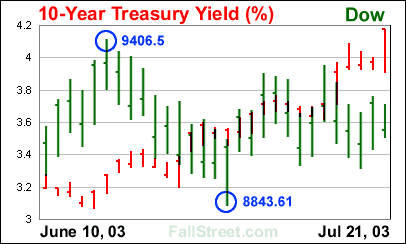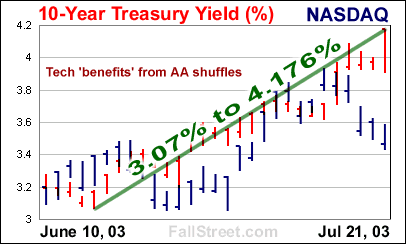July 22, 2003
AA Speculators Get Rude Awakening
With tech the only area of the marketplace showing any real momentum improvement since bonds yields bottomed, where is all the money coming out of bonds going?
The basic speculation in mid-June was that asset allocation (AA) switches – from safe bonds to risky stocks – would imminently take place and propel stock prices even higher. In fact, with bond yields at historic lows, monetary and fiscal supply-side schemes seemingly united with historic congruency, and stock friendly dividend/capital gains taxation laws due to arrive in 2004, this seemed to be not so much a speculation, but a matter of fact.
However, a funny thing has happened since June 16 (or when the 10-year Treasury yield struck an intraday low of 3.07%). Instead of rallying as money has flowed out of bonds, stocks have mostly declined or remained flat. Furthermore, as bond yields have begun to rise more rapidly (following Greenspan’s comments last week), stocks have begun to decline more rapidly. In short, even those investors that positioned themselves in SPDRs in mid-June – or those that timed the bond markets peak to perfection – are staring at paper losses today.
 |
Similarly, the Dow investor speculating that inflows from AA shifts would imminently boost stocks on June 16 is also staring at paper losses today.
 |
Suffice it to say, the great AA rally being touted by market bulls in June has not come to pass. Accordingly, the speculation to be made now – especially after many ‘good’ EPS results have prompted ‘buy the rumor sell the news’ type free falls – is that the so called ‘smart money’ was advertising the AA theory hoping to instill a greater fool type euphoria in stocks. In other words, the smart money wanted to sell, but hopefully on further equity strength. If this was the case, the adage ‘do what I say, not what I do’ comes to mind. In short, given Wall Street and corporate America’s history of lying to investors (i.e. the 1990s), if insiders and institutions were taking some money off the table as they implored retail investors to ‘buy!’ this would hardly be shocking.
Yet before concluding that the AA switch was a complete failure, there is one area of the markets that have benefited since mid-June. You guessed it, TECH. As bonds have topped out and sunk – giving back all of their gains this year - the Nasdaq investor has been rewarded.
 |
Given that tech has been leading the markets, it is not surprising that some of the most violent post-earnings sell offs have been concentrated in these stocks. Regardless, since the Nasdaq closed less than 20 point higher than it was when the 10-year was at 3.07%, the word ‘benefit’ should be used lightly.
Deficit Outlook Stokes Bond Fears
With the proverbial ‘bond bubble’ showing signs of strain, it is worth noting that simple supply/demand considerations are not as applicable in the bond market as in the stock market. To be sure, with stocks the float of outstanding shares remains relatively constant. Therefore, to conjure up speculations of stock price movements one need only consider who is buying/selling. By contrast, with government bonds the float (outstanding bonds) is constantly changing as the government issues new bonds and/or older bonds mature.
Point being, as the U.S. government continues to issue bonds to fund deficits (August refunding could see the issuance of more than $60 billion in Treasuries), prices are not necessarily determined by who is buying or selling, but by how large government bond issuance is. Thus, when people generalize that deficits are implicitly inflationary, it is not necessarily because supply-side economics always promotes an inflationary economic turnaround, but because the issuance of government bonds can overrun demand (even if demand is generally considered to be ‘strong’).
Separating ‘issuance pressures’ to that of ‘selling pressures’ may seem like a trivial pursuit. After all, the government is selling bonds when they issue. Nevertheless, just as a company issuing new stock because of financial troubles can be looked at in a negative light by investors, the same perception can take hold in the bond market. With deficit fears resurging in recent weeks – the buzz word today is ‘deficits’ not ‘deflation’ – bond investors have been spooked by oversupply fears.
Such is why Greenspan’s Testimony last week was important. When the bond market sold off on Tuesday, Greenspan came back on Wednesday and essentially begged investors to keep buying bonds (Mr. G suggested that if investors didn’t keep the long end of the curve ‘low’ the Fed would). In ‘short’, Greenspan wants to keep ‘deflation’ in the spotlight so that ‘deficit’ fears do not stifle demand for bonds. If the last week is used as a guide, he has failed miserably.
From Bonds to Equities?
Notwithstanding the Fed’s quarterly Flow of Funds report, and other liquidity reports, an exact answer to where money from the bond market is moving into is impossible to determine in a timely manner. However, with regards to asset allocations, it is worth remembering that capital flows are not confined to simply stocks and bonds. After all, bonds have ‘peaked’, and thanks to the Fed’s last rate cut many money market investors are now holding underwater instruments, yet stocks have not broadly benefited.
As for the argument that AA shifts have been occurring since March (that stocks have already benefited because money has moved out of bonds), this speculation undoubtedly holds some truth. However, that stocks and bonds have not been connecting since mid-June could be cause for alarm.
The simple truth – for the bearish observer – is that stocks previously benefited from declining bond yields because investor’s believed that lower interest rates would surely spark a strong economic recovery. Does this optimistic perception now lead to a more rational stock/bond relationship -- do rising yields signal that the economic recovery is in jeopardy?
According to Bank One Capital Chief Economist Anthony Chan, “in the last four decades the 10-year yield has risen by at least 100 basis points over a period of six months just eight times and in most of those instances, the higher rates took a serious toll on home sales.” Do rising bond yields threaten to take down the strong U.S. housing market? Given that the U.S. housing market has been supporting the U.S. economy for the last two years, this question is worth remembering.
Suffice it to say, rising bond yields could mean that money is less attracted to bonds and/or that supply/deficit fears are ebbing back into the marketplace, but rising bond yields do not mean that stocks are attractive. Rather, Wall Street previously tried to coax more capital into stocks based upon AA shift speculations because Wall Street views everything – rising or falling bond yields – in the most optimistic light. Rather than argue that there is some disequilibrium in the stock/bond markets because money flows out of bonds are not landing in equities, it may be more astute to conclude that the natural equilibrium between stocks/bonds is returning.
“Higher Treasury yields could draw money away from equities…” CNN/Money
From March to June 2003 stocks and bonds rallied hand and hand. It was a magical and rare period to behold. Yet as competition for capital returns to the marketplace the AA speculators that timed the bond markets peak perfectly and purchased stocks wonder what went wrong. In the background, sure to enter the foreground again soon, sits the dollar…
a